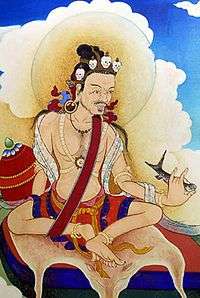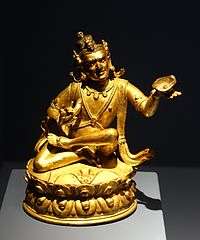Tilopa
Tilopa (Prakrit; Sanskrit: Talika or Tilopadā) (988–1069) was born in either Chativavo (Chittagong), Bengal or Jagora, Bengal in India. He was a tantric practitioner and mahasiddha. He practiced Anuttarayoga Tantra, a set of spiritual practices intended to accelerate the process of attaining Buddhahood. Naropa is considered his main student. At Pashupatinath temple premise, greatest Hindu shrine of Nepal, there are two caves where Tilopa attained Siddhi and initiated his disciple Naropa.

Life
Tilopa was born into the priestly caste – according to some sources, a royal family – but he adopted the monastic life upon receiving orders from a dakini (female buddha whose activity is to inspire practitioners) who told him to adopt a mendicant and itinerant existence. From the beginning, she made it clear to Tilopa that his real parents were not the persons who had raised him, but instead were primordial wisdom and universal voidness. Advised by the dakini, Tilopa gradually took up a monk's life, taking the monastic vows and becoming an erudite scholar. The frequent visits of his dakini teacher continued to guide his spiritual path and close the gap to enlightenment.[1]
He began to travel throughout India, receiving teachings from many gurus:
- from Saryapa he learned of inner heat (Sanskrit: caṇḍalī, Tib. tummo, inner heat);
- from Nagarjuna he received the radiant light (Sanskrit: prabashvara) and illusory body (Sanskrit: maya deha, Tib. gyulu) teachings (Cakrasaṃvara Tantra), Lagusamvara tantra, or Heruka Abhidharma);
- from Lawapa, the dream yoga;
- from Sukhasiddhi, the teachings on life, death, and the bardo (between life states, and consciousness transference) (phowa);
- from Indrabhuti, he learned of wisdom (prajña);
- and from Matangi, the resurrection of the dead body.
As advised by Matangi, Tilopa started to work at a brothel in Bengal for a prostitute called Dharima as her solicitor and bouncer. During the day, he was grinding sesame seeds for his living.[2] During a meditation, he received a vision of Vajradhara and, according to legend, the entirety of mahamudra was directly transmitted to Tilopa. After having received the transmission, Tilopa embarked on a wandering existence and started to teach. He appointed Naropa, his most important student, as his successor.[1]
Teachings

Six Precepts or Words of Advice
Tilopa gave Naropa a teaching called the Six Words of Advice, the original Sanskrit or Bengali of which is not extant; the text has reached us in Tibetan translation. In Tibetan, the teaching is called gnad kyi gzer drug[3] – literally, "six nails of key points" – the aptness of which title becomes clear if one considers the meaning of the English idiomatic expression, "to hit the nail on the head.”
According to Ken McLeod, the text contains exactly six words; the two English translations given in the following table are both attributed to him.
| First short, literal translation | Later long, explanatory translation | Tibetan (Wylie transliteration) | |
|---|---|---|---|
| 1 | Don't recall | Let go of what has passed | mi mno |
| 2 | Don't imagine | Let go of what may come | mi bsam |
| 3 | Don't think | Let go of what is happening now | mi sems |
| 4 | Don't examine | Don't try to figure anything out | mi dpyod |
| 5 | Don't control | Don't try to make anything happen | mi sgom |
| 6 | Rest | Relax, right now, and rest | rang sar bzhag |
Watts-Wayman translation
An earlier translation circa 1957 by Alan Watts and Dr. Alex Wayman rendered Tilopa's "Six Precepts" as
- No thought, no reflection, no analysis,
- No cultivation, no intention;
- Let it settle itself.
In a footnote, Watts cited a Tibetan source text at partial variance with McLeod's in sequence and syntax, namely:
- Mi-mno, mi-bsam, mi-dpyad-ching,
- Mi-bsgom, mi-sems, rang-babs-bzhag.
Based on an "elucidation" provided by Wayman, Watts explained that
- Mi-mno is approximately equivalent to the Zen terms wu-hsin or wu-nien, “no-mind” or “no thought.” Bsam is the equivalent of the Sanskrit cintana, i.e., discursive thinking about what has been heard, and dpyad of mimamsa, or “philosophical analysis.” Bsgom is probably bhavana or the Chinese hsiu, “to cultivate,” “to practice,” or “intense concentration.” Sems is cetana or szu, with the sense of intention or volition. Rang-babs-bzhag is literally “self-settle-establish,” and “self-settle” would seem to be an almost exact equivalent of the Taoist tzu-jan, “self-so,” “spontaneous,” or “natural.”[4]
Watts had studied Chinese, and Wayman was a Tibetologist and professor of Sanskrit associated with UCLA and later Columbia University.
Mahamudra instructions
Tilopa also gave mahamudra instruction to Naropa by means of the song known as "The Ganges Mahamudra,"[5] one stanza of which reads:
Attachment and enjoyment
One of the most famous and important statements attributed to Tilopa is: “The problem is not enjoyment; the problem is attachment.”
See also
- Erdne Ombadykow, as Telo Tulku Rinpoche, supposed reincarnation of Tilopa
- History of Tibet
References
- The Life of the Mahasiddha Tilopa by Chos-Kyi Blo-Gros Marpa
- Kagyu Lineage History: Tilopa Archived 28 February 2013 at the Wayback Machine
- Tsele Natsok Rangdröl (tr. Erik Pema Kunsang), Lamp of Mahamudra: The Immaculate Lamp that Perfectly and Fully Illuminates The Meaning of Mahamudra, The Essence of All Phenomena, Boston & Shaftesbury: Shambhala, 1989, p. 72 and n. 18.
- The Way of Zen by Alan Watts (© Pantheon NY, 1957), Vintage Books paperback 1999, p. 79 and n. 3
- "The Life of Tilopa and the Ganges Mahamudra"
- Keith Dowman / Tilopa's Instruction to Naropa
Bibliography
- Rinpoche, Chökyi Nyima; Nyima, Rinpoche Chokyi (1994). Union of Mahamudra and Dzogchen. Rangjung Yeshe Publications. ISBN 978-962-7341-21-5.
- Blo-Gros, Mar-Pa Chos-Kyi; (Na-ga.), Saṅs-rgyas-bstan-dar (1995). The Life of the Mahāsiddha Tilopa. Library of Tibetan Works and Archives. ISBN 978-81-85102-91-7.
- Rinpoche, Sangyes Nyenpa (2014). Tilopa's Mahamudra Upadesha: The Gangama Instructions with Commentary. Shambhala Publications. ISBN 978-0-8348-2974-9.
External links
- An English translation of "The Ganges Mahamudra"
- Several English translations of "The Ganges Mahamudra"
| Wikiquote has quotations related to: Tilopa |
| Preceded by Dorje Chang |
Kagyu school | Succeeded by Naropa |